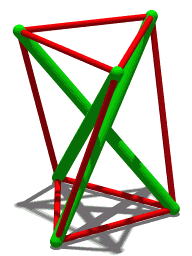Polyledra v2: LED tensegrity
(For v1, see Polyledra v1: LED tetrahedron)
Inspiration§
A tensegrity is a structural principle based on a system of isolated components under compression inside a network of continous tension, and arranged in such a way that the compressed members (struts) do not touch each other while the prestressed tensioned members (tendons) delineate the system spatially.
The term was coined by Buckminster Fuller in the 1960s as a portmanteau of “tensional integrity”



Tensegrity prototype§


Controller§
This time I wanted to use more “off-the-shelf” LED software and hardware.
- Software: WLED
- Hardware: QuinLED-Dig-Uno
Strut design§
Bill of materials:
- aluminium extruded round tube (12.7mm outer diameter, 0.9mm thickness)
- acrylic round tube (40mm outer diameter)
- 4x 3d printed spacers
- 2x 3d printed end links
- 2x 3d printed end caps
- XT60 connectors (power)
- 2 pin electrical cable (power)
- WS2811 LED strips (White PCB, 5m 60 LEDs IP65)
- 3 pin 0.5mm^2 20AWG waterproof electrical cable (LED)
- 3 pin “small size” waterproof IP65 LED connector (LED)
Benefits of aluminium tube inner:
- Acts as heatsink for LEDs
- Can feed power cable through tube to other side
Since I couldn’t find acrylic tubes long enough, I “welded” multiple tubes together with solvent cement.
Strut assembly§

The acrylic tubes are sanded to achieve a diffuser effect.


Double doof sticks§
I also made two portable “doof sticks” based on the same strut designs, with further 3d printed sections for: batteries, bi-directional power converter, power switch, power plug, WLED controller, and button interface. All solvent welded together.

Look amazing, but fragile.
Tensegrity design§
Bill of materials:
- 6x LED struts
- 3x 6x Tendons
- Shock cord
- Shock cord end hooks
Each strut connects with:
- The neighbor struts at the top
- The neighbor struts at the bottom
- The neighbor struts from top to bottom

Tensegrity assembly§




Ignition§

Kiwiburn§

